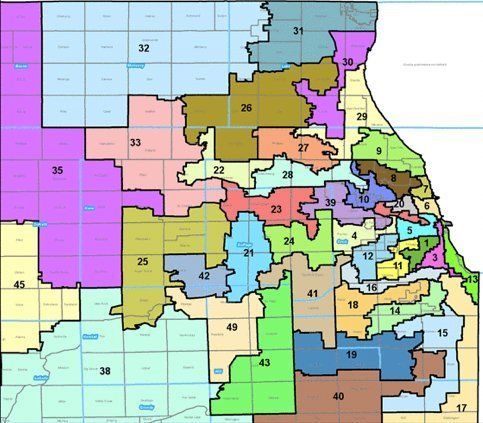
Illinois lawmakers are expected to vote this week on one of the most contentious parts of their job: the decennial process of redrawing legislative maps.
To those not mired in the ins and outs of Springfield politicking, the process can seem like an arcane game of inside baseball, with snaking, gerrymandered lines carving the state up into oddly shaped House and Senate districts.
But the mapmaking that happens this week will determine the political futures of some of the state's veteran politicians, chart the racial makeup of the state's body politic, and lay the groundwork for the major political battles of the next ten years.
In the past week, the State House and Senate have released their draft maps and held hearings to receive community feedback. HuffPost Chicago has broken out the most important changes that the new maps appear poised to bring.
Salt in the Wounds
Despite a Republican wave that turned many state legislatures from blue to red in 2010, the Democrats retained control of both houses in Springfield, as well as the Governor's mansion. And they don't plan on letting their Republican colleagues forget it.
Several Republican senators and representatives have been redrawn into districts with their peers. The most prominent case is that of Senate Minority Leader Christine Radogno, who appears likely to share a district with Republican Sen. Ron Sandack. Faced with the choice of running in a primary against his party's leader, Sandack appears likely to run for a House district instead.
In other cases, Republican legislators' homes have been drawn out of the districts they represent, meaning they'd have to move -- and engage an entirely new group of voters -- in order to keep their jobs.
Racial Ups and Downs
The 2010 Census, on which the remapping is based, showed some striking demographic shifts in the state of Illinois. The state's black population saw a marked decline from the year 2000, while Latinos became a much larger percentage of the general population, experiencing a 32.5 percent increase in numbers.
It would seem natural, then, for the number of majority-black districts to decrease, and for Latino legislators to increase in number. But that's a tricky proposition for Democrats, to whom both groups are important constituents: disempowering African-Americans could be a dangerous move for the Springfield Dems.
The proposed maps are an attempt at that high-wire balancing act of keeping black legislators in power while also bolstering Latino representation.
House Democrats have drawn 16 districts with African-American majorities, and 11 where more than 50 percent of the voting-age population is Latino. That is a slight adjustment from the 18 majority-black and eight majority-Latino districts currently in the House.
But Hispanic advocacy groups point out that they outnumber African-Americans in the state, and the United Congress of Community and Religious Organizations showed a map at a recent hearing that created some 57 majority-minority districts in the House and Senate combined. They hope to see some lines adjusted to add to the minority representation before the maps get passed.
Bomb the Suburbs
A quick glance at the odd appearance of the proposed Senate legislative map reveals an odd pattern: in Cook County and the surrounding areas, a number of districts reach into Chicago and then out to cover extended areas of the suburbs.
This isn't an accident. The suburban areas of the collar counties are purple and trending red. As a result, mapmakers squeezed as much of that territory into districts with safely Democratic Chicago to deprive suburban Republicans of additional votes in Springfield.
“The General Assembly just ignores this community,” Mary Schaafsma of the League of Women Voters of Illinois told the Chicago News Cooperative. “When representatives are elected from a base in Chicago, they are concerned with that base and not so much with voters living in the outlying areas of their districts.”
The Rush
One thing that almost all parties at the redistricting hearings -- from progressive Democrats to Republican elected officials -- have complained about has been the haste with which the maps were unveiled and are expected to see a vote.
But there's a reason for the speed. If Democrats don't get the new maps passed by June 1st, they will require a two-thirds supermajority for passage. That would mean bringing Republicans into the process, which, given the heavily pro-Democratic nature of the maps as they are now, would likely mean starting from scratch.
What About Congress?
Still to be revealed are plans for the U.S. Congressional districts. But if the state legislative maps are any guide, there will likely be some consolidation of Republican districts in an attempt to increase Democratic representation in the state's delegation.
The most likely targets are freshman Republicans like Robert Dold, Adam Kinzinger and Joe Walsh, who came in on the 2010 wave. Springfield Dems are likely to combine the districts of two or more of these new legislators to force them to compete, hoping to add several blue districts to what is looking more and more like a red state.